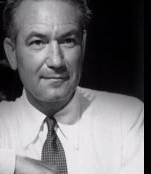|
|
| Fleming, Victor
 |
Date of birth
23 February 1883, Pasadena, California, USA
Date of death
6 January 1949, Cottonwood, Arizona, USA
Mini biography
Victor Fleming
(February 23rd, 1883 - January 6th, 1949)
Victor Fleming entered motion pictures as a combination driver and stunt man at the Flying A studio in Santa Barbara, California, in 1912, following a series of jobs that included bicycle mechanic, taxi driver, auto mechanic, chauffeur and auto salesman.
Allan Dwan took credit for hiring him after he repaired Dwan’s car, but Fleming’s real conduit was his actor pal Marshall Neilan, whom he had met as a chauffeur.
“Don’t get excited. Obstacles make a better picture.”
After two years with Flying A, Fleming joined Neilan at Kalem, making the early Ham and Bud comedies, and in 1915, he joined the Douglas Fairbanks unit at Triangle, where he worked under Dwan and John Emerson.
His first picture there was The Habit of Happiness, and he was one of several cameramen who worked on D.W.
Griffith’s Intolerance in 1916. By the outbreak of World War I, Fleming was Fairbanks’ supervisory cameraman at ArtCraft Pictures.
After Signal Corps service that included serving as President Woodrow Wilson’s personal cameraman at the Versailles Peace Conference, Fleming rejoined Fairbanks at the newly formed United Artists, where in 1919, he directed his first picture, When the Clouds Roll By.
Later at Paramount, Fleming’s first major success was Lord Jim (1925). The following year, he brought Clara Bow to fame in Mantrap, filmed the now-lost Spanish-American War epic The Rough Riders, and in 1927 he was Emil Jannings’ first American director with The Way of All Flesh.
Fleming’s first all-sound film, The Virginian, established Gary Cooper’s laconic character.
At MGM, Fleming vaulted Clark Gable to stardom with Red Dust (1932) and began a string of fast-paced hits with Bombshell (1933), Treasure Island (1934), Captains Courageous (1937) and Test Pilot (1938).
He also remade a large portion of The Great Waltz (1938) after the studio fired original director Julien Duvivier.
Fleming took over The Wizard of Oz from Richard Thorpe in October 1938, but before he finished that picture, was asked to take over David Selznick’s troubled production of Gone With the Wind from George Cukor.
In the following decade, all but Fleming’s last picture, Joan of Arc (1948) were box office successes, particularly A Guy Named Joe with Spencer Tracy and Irene Dunne, one of MGM’s top grossers for 1944.
At the time of his death in January 1949, Fleming was planning to film The Robe, later made at 20th Century Fox in 1952. -- IMDb
Director - Selected filmography
-
The Wizard of Oz (1939)
-
Gone with the Wind (1939)
|
|
|
| Choose an item to go there!
|
|

